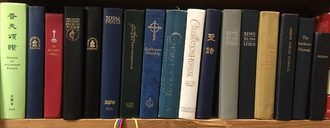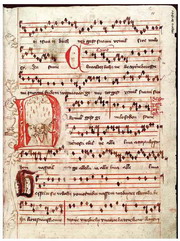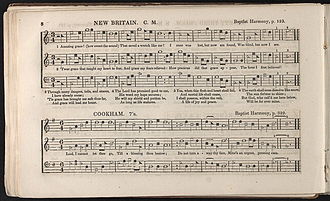Hymnal
This article has multiple issues. Please help improve it or discuss these issues on the talk page. (Learn how and when to remove these template messages)
|


A hymnal or hymnary is a collection of hymns, usually in the form of a book, called a hymnbook (or hymn book). They are used in congregational singing. A hymnal may contain only hymn texts (normal for most hymnals for most centuries of Christian history); written melodies are extra, and more recently harmony parts have also been provided.
Hymnals are omnipresent in churches but are not often discussed; nevertheless, liturgical scholar Massey H. Shepherd once observed: "In all periods of the Church's history, the theology of the people has been chiefly molded by their hymns."[1]
Elements and format
Since the twentieth century, singer-songwriter hymns have become common, but in previous centuries, generally poets wrote the words, and musicians wrote the tunes. The texts are known and indexed by their first lines ("incipits") and the hymn tunes are given names, sometimes geographical (the tune "New Britain" for the incipit "Amazing Grace, how sweet the sound"). The hymnal editors curate the texts and the tunes. They may take a well-known tune and associate it with new poetry, or edit the previous text; hymnal committees are typically staffed by both poets and musicians. Some hymnals are produced by church bodies and others by commercial publishers.
In large denominations, the hymnal may be part of a coordinated publication project that involves several books: the pew hymnal proper; an accompaniment version (e.g. using a ring binder so that individual hymns can be removed and sit nicely on a music stand); a leader's guide (e.g. matching hymns to lectionary readings); and a hymnal companion, providing descriptions about the context, origin and character of each hymn, with a focus on their poets and composers.
Service music
In some hymnals, the front section is occupied by service music, such as doxologies, three-fold and seven-fold amens, or entire orders of worship (Gradual, Alleluia, etc.). A section of responsorial psalms may also be included.
Indexes
Hymnals usually contain one or more indexes; some of the specialized indexes may be printed in the companion volumes rather than the hymnal itself. A first line index is almost universal. There may also be indexes for the first line of every stanza, the first lines of choruses, tune names, and a metrical index (tunes by common meter, short meter, etc.). Indexes for composers, poets, arrangers, translators, and song sources may be separate or combined. Lists of copyright acknowledgements are essential. Few other books are so well indexed; at the same time, few other books are so well memorized. Singers often have the song number of their favorite hymns memorized, as well as the words of other hymns. In this sense, a hymnal is the intersection of advanced literate culture with the persistent survival or oral traditions into the present day.
History

Origins in Europe
The earliest hand-written hymnals are from the
Hymnals in Early America
Market forces rather than denominational control have characterized the history of hymnals in the thirteen colonies and the antebellum United States; even today, denominations must yield to popular tastes and include "beloved hymns" such as Amazing Grace[3] and Come Thou Fount of Every Blessing,[4] in their hymnals, regardless of whether the song texts conform to sectarian teaching.
The first hymnal, and also the first book, printed in
In 1801, the tunebook market was greatly expanded by the invention of
Southern Shape Note Hymnals (Tunebooks)

Southerners identified with folk hymns of Wyeth's 1813 Part Second and collected more: the titles of
The Better Music Movement in the Industrialized North
In the North, the "
Hymns Ancient and Modern appears in England
In England, the growing popularity of hymns inspired the publication of more than 100 hymnals during the period 1810–1850.[9] The sheer number of these collections prevented any one of them from being successful.[10] In 1861, members of the Oxford Movement published Hymns Ancient and Modern under the musical supervision of William Henry Monk,[11] with 273 hymns. For the first time, translations from languages other than Hebrew appeared, the "Ancient" in the title referring to the appearance of Phos Hilaron, translated from Greek by John Keble, and many hymns translated from Latin. This was a game-changer. The Hymns Ancient and Modern experienced immediate and overwhelming success.[10] Total sales in 150 years were over 170 million copies.[11] As such, it set the standard for many later hymnals on both sides of the Atlantic.[10] English-speaking Lutherans in America began singing the metrical translations of German chorales by Catherine Winkworth and Jane Laurie Borthwick, and rediscovered their heritage. Although closely associated with the Church of England, Hymns Ancient and Modern was a private venture by a committee, called the Proprietors, chaired by Sir Henry Baker.[11]
See also
- List of Chinese hymn books
- List of English-language hymnals by denomination
- Hymnody of continental Europe
References
- JSTOR 1291174.
- ^ Settari, Olga (1994). "The Czech sacred song from the period of the Reformation" (PDF). Sborník prací filozofické fakulty brněnské univerzity. Studia minora facultatis philosophicae universitatis Brunensis. H 29.
- ^ For example, strictly speaking, Lutherans should not sing "grace... taught my heart to fear," because they believe that it is the Word of God, ministered through divine grace, that teaches the heart and mind. The Wisconsin Evangelical Lutheran Synod resisted until the 2005 publication of Christian Worship: A Lutheran Hymnal. Almost all hymnal committees choose to omit the final, apocalyptic verse ("The earth will soon dissolve like snow").
- ^ Every hymnal committee edits this a different way.
- ISBN 9781602397064.
- ^ "The Bay Psalm Book". World Digital Library. Library of Congress. Retrieved 7 December 2017.
- ISBN 0-691-09118-8.
- ^ The hymn text was usually literary: Watts, Wesley, and Newton being the most popular.
- ^ Julian, John (1892). Dictionary of Hymnology. John Murray.
- ^ ISBN 9780805498257.
- ^ a b c "The History and Traditions". Hymns Ancient & Modern. Retrieved 26 December 2014.
External links
- "SDA Hymnal online"
- "Hymnary.org". Archived from the original on 2013-03-02. Retrieved 2020-01-19. — Extensive database of hymns and hymnology resources; incorporates the Dictionary of North American Hymnology, a comprehensive database of North American hymnals published before 1978.
- "SDA Hymnal Songs"
